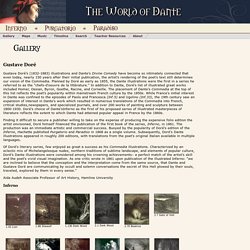

Artists Illustrate Dante's Divine Comedy Through the Ages: Doré, Dalí, Blake, Botticelli, Mœbius & More. For a book about medieval theology and torture, filled with learned classical allusions and obscure characters from 13th century Florentine society, Dante Alighieri’s Inferno, first book of three in his Divine Comedy, has had considerable staying power, working its way into pop culture with a video game, several films, and a baleful appearance on Mad Men.

While the Mad Men reference may be the more literary, the former two may hint at the more prominent reason the Inferno has captivated readers, players, and viewers for ages: the lengthy poem’s intensely visual representation of human extremity makes for some unforgettable images. Like the rest of us, artists have been drawn to Dante’s extraordinary images and extensive fantasy geography since the Divine Comedy first appeared (1308-1320). In prolific French artist Gustave Doré’s rendering of the ninth circle scene, above, Satan is a huge, bearded grump with wings and horns. Related Content: Botticelli's 92 Illustrations of Dante's Divine Comedy - Every true Renaissance man needed a wealthy patron, and many Italian artist-inventor-scholar-poets found theirs in Lorenzo de’Medici, scion of a Florentine dynasty and himself a scholar and poet.

Lorenzo either sponsored directly or helped secure commissions for such 15th century art stars as Michelangelo Buonaroti and Leonardo da Vinci. Among Lorenzo’s many artist friends was a painter who mostly disappeared from history until the late nineteenth century, when the rediscovery of his Primavera and Birth of Venus made him one of the most popular of Renaissance artists. Salvador Dalí's 100 Illustrations of Dante's The Divine Comedy. In 1957, the Italian government commissioned Salvador Dalí to paint a series of 100 watercolor illustrations of Dante’s Divine Comedy, the greatest literary work written in the Italian language.

The illustrations were to be finished by 1965, the 700th anniversary of the poet’s birth, and then reproduced and released in limited print editions. The deal fell apart, however, when the Italian public learned that their literary patrimony had been put in the hands of a Spaniard. Undeterred, Dalí pushed forward on his own, painting illustrations for the epic poem that collectively recount Dante’s symbolic travels through Hell, Purgatory and Heaven. After Dalí did his part, the project was handed over to two wood engravers, who spent five years hand-carving 3,500 blocks used to create the reproductions of Dalí’s masterpiece. Almost 50 years later, print editions can still be purchased online. “Dali’s portrayal of Sordello drawing a line in Purgatory, delimiting his freedom once night falls.” William Blake's Last Work: Illustrations for Dante's Divine Comedy (1827) Just over a year ago, we featured John Milton’s Paradise Lost as illustrated by William Blake, the 18th- and 19th-century English poet, painter, and printmaker who made uncommonly full use of his already rare combination of once-a-generation literary and visual aptitude.

Blake may have had an obsession with Paradise Lost, as Josh Jones pointed out in that post, but it hardly kept him from illustrating other texts. Today we have his artistic accompaniment to that text that has gone under the hands of Salvador Dalí, Gustave Doré, Alberto Martini, Sandro Botticelli, and Mœbius, to name a few: Dante Alighieri’s Divine Comedy. Blake never completed the full set of engravings commissioned, but only because death itself cut the project short. Yet Blake and Dante had common ground. Via Brain Pickings Related Content:
The World of Dante. Gustave Doré's (1832-1883) illustrations and Dante's Divine Comedy have become so intimately connected that even today, nearly 150 years after their initial publication, the artist's rendering of the poet's text still determines our vision of the Commedia.

Planned by Doré as early as 1855, the Dante illustrations were the first in a series he referred to as the "chefs-d'oeuvre de la littérature. " Gustave Doré's Dramatic Illustrations of Dante's Divine Comedy - Inferno, Canto X: Many artists have attempted to illustrate Dante Alighieri's epic poem the Divine Comedy, but none have made such an indelible stamp on our collective imagination as the Frenchman Gustave Doré.

Doré was 23 years old in 1855, when he first decided to create a series of engravings for a deluxe edition of Dante's classic. He was already the highest-paid illustrator in France, with popular editions of Rabelais and Balzac under his belt, but Doré was unable to convince his publisher, Louis Hachette, to finance such an ambitious and expensive project. The young artist decided to pay the publishing costs for the first book himself.
When the illustrated Inferno came out in 1861, it sold out fast. Hachette published Purgatorio and Paradiso as a single volume in 1868. The scene above is from Canto X of the Inferno. My eyes were fixed on him already.